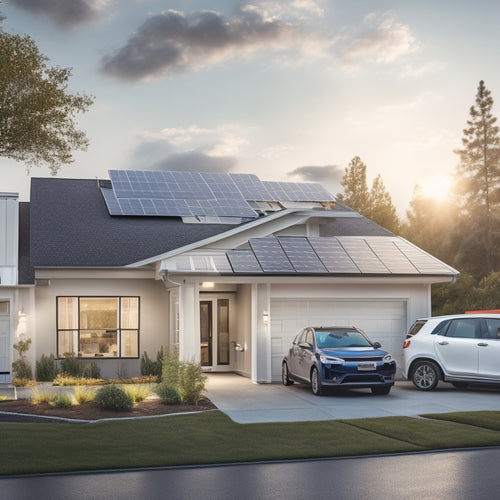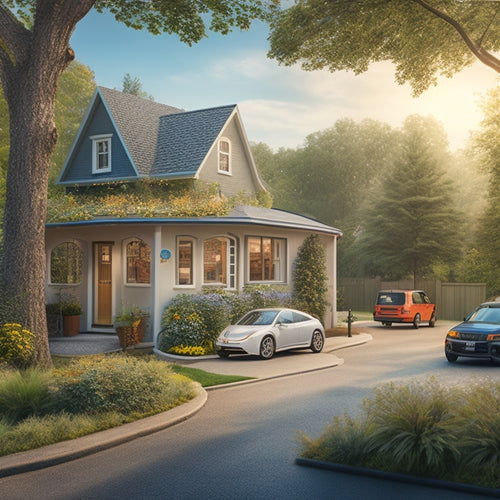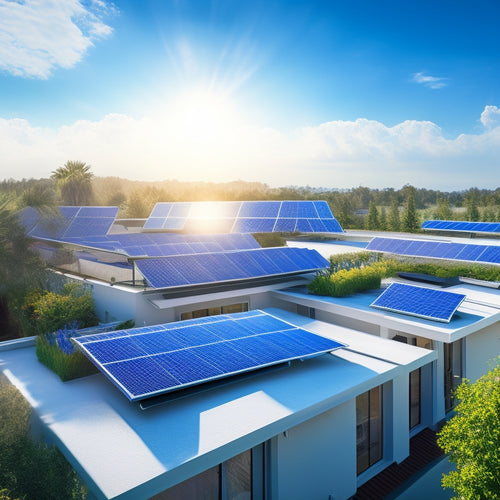
What Does It Cost to Install Solar Panels in a Residential Home?
Share
You're investing in a residential solar panel system, which means you're committing to a long-term energy solution that requires an initial upfront cost of $15,000 to $30,000, depending on the system's size, quality, and installation complexity. This cost includes panels, inverters, and labor, and can be offset by potential savings of $400-$1,000 annually. Factors like roof size, local incentives, and equipment quality also impact the final bill. As you examine your options, you'll want to evaluate how these variables affect your total investment and long-term returns.
Key Takeaways
- The average cost of a residential solar panel system ranges from $15,000 to $30,000, with financing options available to spread the cost over time.
- Installation costs vary depending on factors such as roof size and design complexity, local incentives, and equipment quality, with typical hardware and installation costs around $2.50 to $3.50 per watt.
- Federal and state incentives, such as the 26% Federal Tax Credit, can significantly reduce the upfront cost of installation, making solar energy more accessible.
- Ongoing maintenance expenses, including seasonal cleaning and performance monitoring, are necessary to ensure optimal efficiency and can range from $100 to $1,500 per year.
- Solar panels can pay for themselves in 5-7 years, with potential annual energy savings of $400-$1,000, making them a long-term investment in energy efficiency and property value.
Understanding Solar Panel Costs
Your expedition to utilizing renewable energy begins with a vital question: how much do solar panels cost? As you contemplate moving to solar power, it's important to understand the costs involved.
You're not just investing in a product; you're making a long-term investment in your energy future.
When calculating the cost of solar panels, you'll need to evaluate the upfront installation costs, as well as the potential solar energy savings over time. While the initial investment may seem intimidating, solar panels can provide significant long-term benefits, including reduced electricity bills and a decrease in your carbon footprint.
It's important to factor in the total cost of ownership, including maintenance and repair costs, to get an accurate representation of your solar panel investment.
Average Cost of Solar Panels
The sticker price for solar panels can vary widely, depending on factors such as the system size, panel quality, and installation company. However, on average, you can expect to pay between $15,000 and $30,000 for a residential solar panel system. This cost typically includes the panels, inverters, mounting hardware, and installation labor.
Fortunately, you don't have to pay the full amount upfront. Solar panel financing options are available, allowing you to spread the cost over time. Additionally, the solar energy savings you'll realize over the system's lifespan can help offset the initial investment. In fact, according to the US Department of Energy, a typical residential solar panel system can save you between $400 and $1,000 per year on your electricity bills.
While the average cost of solar panels may seem steep, consider the long-term benefits: reduced energy costs, increased property value, and a smaller carbon footprint.
As you weigh the costs and benefits, keep in mind that the average solar panel system pays for itself in 5-7 years, and can last for 25 years or more.
Factors Affecting Installation Cost
Since you're investing a significant amount in a solar panel system, it's essential to understand what drives the installation cost. Several factors contribute to the overall expense, and being aware of them can help you make informed decisions.
One key factor is installation timing. Installing solar panels during peak season (summer and early fall) can increase costs due to high demand. Scheduling your installation during the off-season (winter and early spring) might result in lower prices from installers looking to fill their pipelines.
Financing options also play a significant role in determining the installation cost. You'll need to evaluate whether you'll pay upfront, finance through a loan, or lease the system. Each option has its pros and cons, and the choice you make will impact your overall expenditure.
Additionally, local and state incentives, permits, and inspections can add to the cost. Understanding these factors will help you budget effectively and get the best value for your investment.
System Size and Cost Breakdown
Determining the ideal system size for your solar panel installation is vital, as it directly impacts the overall cost. A larger system will generate more electricity, but it also increases the upfront cost. You'll want to find a balance between maximizing energy savings and staying within your budget.
To give you a better idea of the costs involved, here's a breakdown of the typical expenses:
-
System hardware and installation: This includes the solar panels, inverters, mounting hardware, and labor costs. Expect to pay around $2.50 to $3.50 per watt, depending on the system efficiency and quality of equipment.
-
Battery storage and grid connection: If you want to store excess energy generated during the day for use at night or during power outages, you'll need a battery storage system. This adds around $1,000 to $2,000 to the overall cost. You'll also need to take into account the cost of connecting your system to the grid.
-
Warranty coverage and maintenance: Look for a provider that offers thorough warranty coverage, including maintenance and repairs, to guarantee your system runs smoothly over its 25-year lifespan.
- Financing options and long-term benefits: Reflect on community solar programs or financing options that allow you to spread the cost over time. With solar panels, you'll enjoy long-term benefits like reduced energy bills, increased property value, and a positive environmental impact.
Roof Size and Complexity Matters
When you're planning to install solar panels, you'll need to take into account your roof's size and complexity, as these factors can greatly impact the installation cost.
For instance, if your roof has multiple levels or an irregular orientation, it may require more panels and specialized mounting systems, increasing the overall cost.
Additionally, the direction your roof faces can also affect the system's energy output, so it's crucial to evaluate your roof's unique characteristics to get an accurate estimate.
Roof Orientation Matters
Frequently, homeowners overlook the importance of roof orientation when evaluating solar panel installation. Your roof's orientation can greatly impact the performance and efficiency of your solar panel system.
Here are four key factors to keep in mind:
-
South-facing roofs are ideal for solar panels, as they receive the most direct sunlight throughout the day.
-
East- and west-facing roofs can still generate a considerable amount of energy, although slightly less than south-facing roofs.
-
North-facing roofs are the least ideal, as they receive the least amount of direct sunlight.
- Roof shading from trees, chimneys, or other obstructions can also impact solar panel efficiency, so it's crucial to assess your roof's shading patterns before installation.
Multiple Roof Levels
Across your roof, multiple levels and varying sizes can greatly impact the complexity and cost of your solar panel installation. A roof design with multiple levels, skylights, or vents can create installation challenges, requiring more materials, labor, and time. This complexity can increase the overall cost of your solar panel system.
| Roof Design | Installation Challenges | Additional Costs |
|---|---|---|
| Multiple levels | Requires additional mounting hardware and labor | 10%-20% increase |
| Skylights or vents | Demands precise panel placement and extra caution | 5%-10% increase |
| Irregular shape | Necessitates custom panel configuration and design | 15%-30% increase |
| Steep pitch | Requires specialized equipment and enhanced safety measures | 20%-40% increase |
When evaluating your roof's complexity, consider the number of levels, obstacles, and unique features. A more complex roof design will typically result in higher installation costs. However, with careful planning and expert installation, you can still reap the benefits of solar energy while minimizing additional expenses.
Quality of Equipment and Materials
The quality of equipment and materials greatly impacts the overall cost of your solar panel installation.
You'll want to take into account the type and quality of solar panels, inverters, and mounting systems you choose, as they can greatly affect the overall performance and durability of your system.
Here are some key factors to take into account:
-
Solar panel efficiency: High-efficiency panels can generate more power per hour of sunlight, but they're often more expensive. Look for panels with high efficiency ratings (e.g., 20% or higher) if you want to maximize your energy output.
-
Equipment warranties: Reputable manufacturers offer thorough warranties that cover parts and labor for 25 years or more. This can provide peace of mind and protect your investment.
-
Inverter quality: A high-quality inverter can guarantee efficient energy conversion and minimize losses. Look for inverters with high efficiency ratings and strong warranties.
- Mounting system durability: A sturdy mounting system can withstand harsh weather conditions and guarantee your panels remain secure. Opt for high-quality mounting systems made from durable materials like anodized aluminum or stainless steel.
Labor Costs and Installation Fees
Generally, labor costs and installation fees account for a significant portion of the total solar panel installation cost. As you're planning your solar panel installation, it's crucial to comprehend the labor costs involved. These costs vary depending on the complexity of the installation, the size of your system, and the local labor market.
| Labor Cost Factors | Description |
|---|---|
| Installation Techniques | The complexity of the installation, including roof type, angle, and obstacles, affects labor costs. |
| Labor Market | The cost of labor in your area, including the competition among installers, influences the overall labor cost. |
| System Size | Larger systems require more labor, increasing the overall cost. |
On average, labor costs range from $2.50 to $3.50 per watt, depending on the installation company and location. For a typical residential solar panel system, labor costs can add up to $10,000 to $15,000. When selecting an installation company, consider their experience, reputation, and the quality of their installation techniques to guarantee you're getting the best value for your money. By understanding these labor cost factors, you can make an informed decision about your solar panel installation.
Incentives and Rebate Opportunities
You'll be pleased to know that the cost of installing solar panels can be offset by various incentives and rebates.
The federal government offers a tax credit of up to 26% of the total installation cost, which can markedly reduce your upfront expenditure.
Additionally, many states and local governments provide their own rebates and incentives, which can further bring down the cost of going solar.
Federal Tax Credit
Installing solar panels can greatly reduce your tax liability through the Federal Tax Credit. This incentive allows you to claim a significant portion of your solar panel installation costs as a credit against your federal income taxes.
To be eligible for the Federal Tax Credit, you must meet certain requirements:
-
You must have a tax liability: The Federal Tax Credit is a non-refundable tax credit, meaning you can only claim it if you have a tax liability.
-
You must own your solar panel system: If you lease your solar panel system, you aren't eligible for the Federal Tax Credit.
-
Your solar panel system must be installed and operational: The Federal Tax Credit is only available for installed and operational solar panel systems.
- Your solar panel system must meet certain quality and efficiency standards: The system must meet certain quality and efficiency standards to be eligible for the Federal Tax Credit.
State and Local
While the Federal Tax Credit provides a considerable incentive for going solar, state and local governments also offer their own set of incentives and rebate opportunities that can further reduce the cost of installing solar panels. As you examine these options, you'll find that state incentives and local regulations vary widely. Some states offer rebates or tax credits, while others have policies that allow you to sell excess energy back to the grid.
Here is a sampling of state and local incentives:
| State | Incentive Type | Amount |
|---|---|---|
| California | Rebate | Up to $1.25/watt |
| New York | Tax Credit | 25% of total cost |
| Massachusetts | Rebate | Up to $1.00/watt |
| Arizona | Property Tax Exemption | 100% of system value |
| Oregon | Tax Credit | 30% of total cost |
Keep in mind that these are just a few examples, and incentives can change over time. Be sure to research the specific opportunities available in your area to maximize your savings. By combining federal, state, and local incentives, you can greatly reduce the upfront cost of installing solar panels and start generating clean energy for your home.
Ongoing Maintenance Expenses
Solar panels require periodic upkeep to guarantee ideal energy production and prolong their lifespan. As a homeowner, you'll need to factor in ongoing maintenance expenses to ascertain your system operates at its best.
Here's what you can expect:
-
Seasonal Maintenance: You'll need to clean your solar panels regularly to maintain their efficiency. Depending on your location, you may need to clean them every 6-12 months, with average costs ranging from $100 to $300 per cleaning.
-
Performance Monitoring: Your solar panel system will require regular monitoring to detect any issues or malfunctions. This can be done remotely or during technician visits, with costs ranging from $100 to $500 per year.
-
Warranty Coverage: While most solar panel systems come with a 25-year warranty, you may need to pay for extended warranty coverage or repairs outside of the warranty period. Average costs for warranty coverage can range from $500 to $1,500 per year.
- Technician Visits: In the event of a malfunction or issue, you may need to hire a technician to inspect and repair your system. Average costs for technician visits can range from $100 to $500 per visit.
Frequently Asked Questions
Can I Install Solar Panels on My Own to Save Money?
You can try DIY installation to save money, but it's essential to weigh the risks; without proper training, you might void warranties or compromise system efficiency, negating potential cost-saving benefits.
Will Solar Panels Increase My Home's Property Value?
You'll be interested to know that homes with solar panels sell for 4.1% more, according to a National Renewable Energy Laboratory study. Installing solar panels will not only enhance your home's value but also provide you with solar incentives and significant energy savings over time.
How Long Does a Typical Solar Panel Installation Take?
You'll typically spend 3-5 days on a solar panel installation, but the timeline varies depending on installation factors, such as roof complexity, system size, and local permits, which can add 1-3 weeks to the overall installation timeline.
Do Solar Panels Work Efficiently in Areas With Heavy Shading?
You're probably wondering if solar panels are a lost cause in areas with heavy shading - a million trees casting shadows on your roof! But, surprisingly, they still work, albeit with a shading impact, causing some efficiency loss, typically around 10-20%.
Are Solar Panels Durable Enough to Withstand Extreme Weather?
You'll be relieved to know that solar panels are built to last, with a typical lifespan of 25-30 years, and are designed to withstand extreme weather conditions, including heavy rain, hail, and high winds, thanks to their strong weather resistance features.
Conclusion
As you consider utilizing the power of the sun, remember that installing solar panels is a significant investment, but one that can yield long-term savings and a reduced carbon footprint. Think of it as planting a tree - the upfront cost is substantial, but with time, it grows into a worthwhile asset, providing shade from rising energy bills and a clear conscience. With careful planning and consideration of the factors affecting installation cost, you can reap the rewards of solar energy for years to come.
Related Posts
-

What Electric Vehicle Owners Need for Home Energy
As an electric vehicle owner, you need to optimize your home energy system to guarantee efficient, sustainable, and c...
-

Why Nearby EV Conversion Shops Matter to You
Having a nearby EV conversion shop means you'll experience the benefits of a more personalized, convenient, and susta...
-

Best Solar Panel Options for Maximum Energy Savings
You can maximize your energy savings with solar panels that boast efficiency ratings above 20%, paired with extensive...


